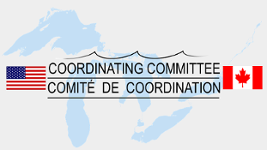Terms of Reference
- Review existing International Great Lakes Datum (IGLD) and revise as appropriate. Issue informational materials, binational standardization guidance and reports for establishing bench mark elevations in the current IGLD reference frame.
- Review and update as necessary vertical crustal and other movement rates between and at water level gauge sites in the Great Lakes-St. Lawrence River System, and report coordinated findings.
- Review and coordinate methodologies and technology for establishing water level measurements and connections to the vertical reference frame at water level gauges (permanent, seasonal, temporary) in the Great Lakes-St. Lawrence River System.
- Review the permanent Great Lakes-St. Lawrence River System water level gauge network, and recommend relocations, additions or deletions to meet the changing needs of the users.
- Review the permanent Global Navigation Satellite Systems (GNSS) based reference station network used for vertical positioning in the Great Lakes-St. Lawrence System. Recommend relocations, additions or deletions to meet the changing needs of the users.
- Update and publish the coordinated histories of water level gauge sites in the Great Lakes-St. Lawrence River System.
- Review and update the method for determining representative lake-wide average water levels for each of the Great Lakes and Lake St. Clair and coordinate the historical statistics for these representative levels.
Working Groups in the Vertical-Control Levels Subcommittee
Hydraulic Correctors
Dan Roman and John Crowley
To integrate the IGLD campaign GNSS heights, geoid model, leveling data, and water gauge measurements to assess the level of agreement in water gauge (dynamic) height across the Great Lakes. Differences in (dynamic) water height between gauges may exist in some cases due to poor data or real dynamic topography from water flow. In these cases, it may be necessary to estimate a hydraulic corrector for the gauges to ensure consistency in water level measurements across a given lake. The goal of the group is to estimate these hydraulic correctors for all gauges on the lake and connecting channels and to provide advice on their possible source (errors in GNSS, geoid, or water gauge data vs. real dynamic topography, wind, etc.).
Station Histories
Terese Herron, Jeff Oyler and Adam Grodsky
To develop and execute a plan (including timeline) to update the existing gauge histories books from a physical book to an online repository. The update will also reflect changes in location, collection frequency and controlling/primary bench mark for all active and historical stations. The books were last updated in 1978 (Upper Great Lakes and St Clair – Detroit Rivers) and 1987 (Lower Great Lakes and International Section of St Lawrence River).
Outreach
Alexis Sluder, Terese Herron
Oversee requests for outreach related to the IGLD update and develop presentations/material relevant to each request. This includes all facets of outreach from social media, presentations, media requests, etc. Determine which conferences/events are the best for personnel to attend to provide updates on IGLD progress.
Water Levels on IGLD 2020
Sierra Davis and Khaleel Arfeen
Develop the methodology for providing water level measurements that are referenced to and tied into the modernized National Spatial Reference System (NSRS), the binationally agreed-upon reference zero, and the GEOID reference surface identified for IGLD (2020). Identify needs of water level users on needs concerning IGLD (2020), data dissemination, and any future updates. Provide recommendations to the Implementation and Maintenance working group, considering these needs of the water level user community.
IGLD Implementation and Maintenance
Jason Bond and Jacob Heck
Provide guidelines to both users in the field and application developers on how to use the new, geoid-based, IGLD datum. The focus is on what happens after ellipsoidal height is obtained using Global Navigation Satellite Services (GNSS). Specific considerations include:
- Determining dynamic heights
- Applying hydraulic correctors
- Building tools to relate current and historic datums
Identification of accuracy deficiencies in the existing model and planning of required fieldwork to achieve desired accuracy levels are part of the ongoing maintenance work. Periodic reprocessing to provide model updates is also required.
Low Water Datum
Terese Herron and Jacob Heck
To review previous Low Water Datum (LWD) established for the Great Lakes to determine:
- If the LWD meets the International Hydrographic Organization (IHO) definition through analysis of the water level data data
- Use the results of the analysis to make recommendations for LWD for IGLD (2020)
- Provide the most up-to-date datums information to the public
- Provide a methodology and document a process to use in the future
GNSS
Ryan Hippenstiel and Mike Craymer
Process data from the 2022 GNSS survey campaign (now meets ad-hoc since processing is nearly completed).
Last revised: 2025-02-26
 Great Lakes Coordinating Committee
Great Lakes Coordinating Committee